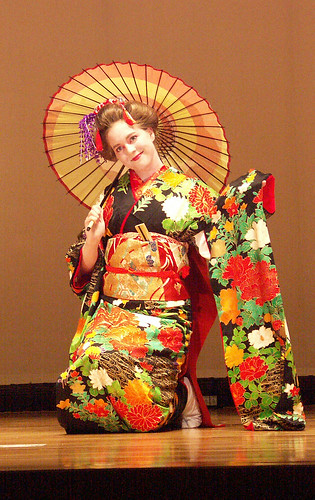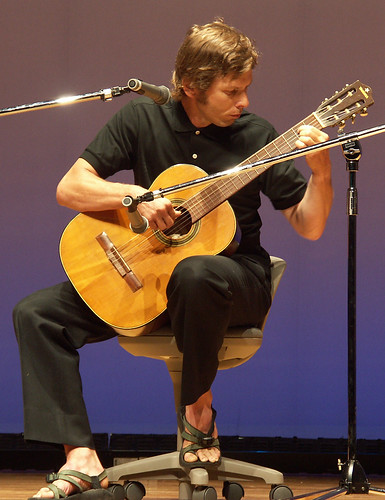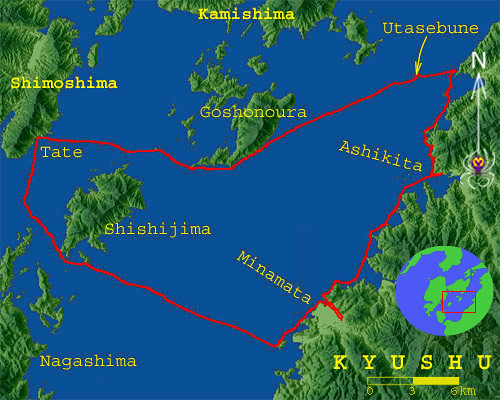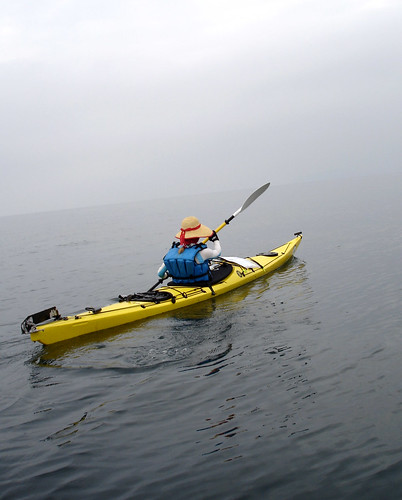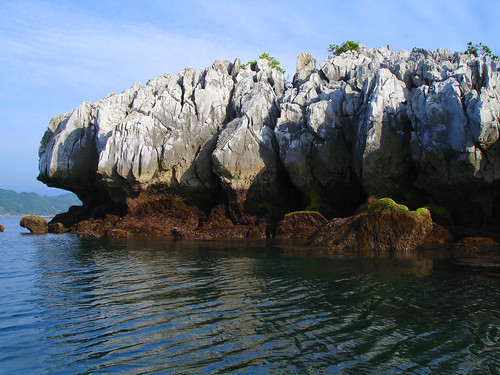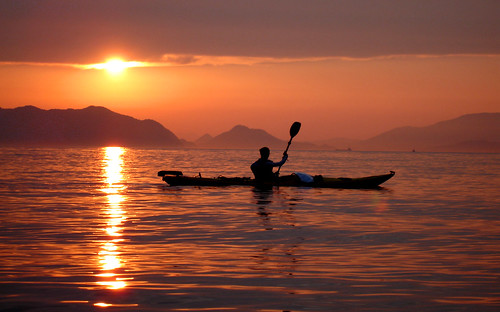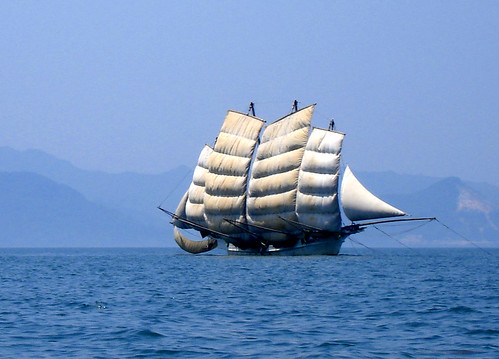Monday, June 20, 2005
Friday, June 17, 2005
YATSUSHIRO TOUR
Trip Length 86km. Time: 2 days. The whole area is subject to significant tidal currents and although their pattern is fairly complicated, it is possible to take good advantage of them. However it was neap tide and we received only slight help from the tidal flows.
The Yatsushiro inland sea to the east of Amakusa separates it from mainland Kyushu. It is shallow and its shores are well populated, including several sizeable cities, so it is not exactly the cleanest body of water around. In fact, the coastal city of Minamata is infamous world-wide for the large-scale mercury poisonings that took place there about 40 years ago, caused by negligent dumping of large amounts of raw industrial waste into the sea and the subsequent consumption of tainted fish by the general populace. However, a portion of the Kyushu coast here is of the rias type with its many capes and inlets; as such it could be of some interest to the itinerant kayaker. This prompted us to give it an exploratory visit.
traverse
In June the stationary front that divides the warm hazy air of the early summer from the truly hot and humid tropical air to the south finally creeps north giving Amakusa a month of unstable, often stormy conditions. We are on the brink of the rainy season and the weather has been warm and very settled, so that the surrounding seas have become smooth as oil. Only the slow, low swell in the open ocean off Ushibuka warns of the slow approach of the front. It’s a good time to make some open water traverses under completely safe, if monotonous, conditions.
Today, tidal currents dictated a 6am start. Two hours later, after clearing the Hachiman and Mebuki Straits, we moved onto the open water of the Yatsushiro Sea. In the hazy stagnant air the opposite shore, 14km distant, was not visible and we both had trouble staying awake as we paddled on. Many times I drifted into semi-consciousness, mechanically paddling off in the wrong direction, waking with a start as I was starting to tip over. Finally the other side emerged from the murky air giving us, at least, something to paddle toward. We made landfall at Koiji Island just west of Minamata Port.
touseniwa
We continued northward past the industrial shores of Minamata City. Morning slumber was replaced by ravenous hunger which our Calorie Mate bars could not satisfy, so we paddled up the river estuary to the highway bridge and ordered takeout from the nearby MOS Burger; this sat heavily in our stomachs for the next couple of hours. North of Minamata we passed the well-known Yunoko Hot Spring Resort. A weird replica of a Spanish or Portuguese sailing ship came into view, incompletely metamorphosed from crude modern materials, and beyond it a small island of black volcanic rock has been bridged over and converted into a park with tropical plants. All this felt about par for the course for this kind of place. The coastline continued in a series of rocky capes containing bays of various sizes, the bigger ones lined with undistinguished-looking towns and villages. The mountain slopes facing the sea held many an orange orchard, and it was perhaps the fertilizer runoff from these that was causing abundant algal growth in the sea, which had become green and opaque. Perhaps the most interesting part of the coast was in Ashikita Town. Here there are some off-lying islets and rocks, one of which, Tousen-iwa (Chinese Boat Rock) is pictured here; it was quite unusual in that it was the only one made of limestone. The naming is curious but not uncommon: Japan having been a closed country for many centuries past, seeing a Chinese boat here (then and now) might seem just as bizarre as the sea- and rain-eroded form of this rock.
sunset
Rice farmers delight at the coming of the rainy season, as do photographers. The moisture-laden air precipitates clouds at all levels, often in interesting shapes and patterns. Sunsets can be quite spectacular. This one caught us off-guard in the midst of our harried efforts to secure both food and a campsite before the light of day faded. Populated as it is, the coast was not overly generous in these respects: stores and restaurants seem to appear only after a paddle and/or walk significantly out of the way, and good campsites are scarce overall. But either can be gotten in a pinch. A tiny shop in a small village was spotted with our handy monocular. It provided a motley selection of traditional and junk food. We judged the nearby artificial beach of Tsuruga-hama OK to spend the night, though a sign says camping and even boating are not allowed. Well, this not being the “swimming season”, no one was there to notice. We were exhausted, sleepy, and hungry, so we consumed the assorted foods a little too quickly and went to bed immediately. The occasional hot-wheels car roared noisily by at night, and at some ungodly hour a noisy group of youths loitered around the beach for a while, but this was scarcely noticed in our state.
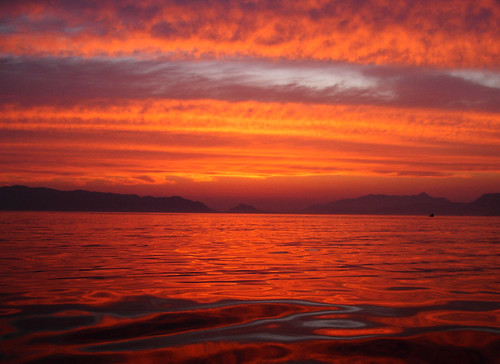
utasebune
Ashikita is the homeport of the unique utasebune, a kind of fishing sailboat that can still be seen in healthy numbers gracing the Yatsushiro Sea. Approaching one on our way back to Amakusa, we could see that the sails are not actually used for propulsion (the boats are motor-equipped), but rather for dragging nets deployed on the boat's windward side. Why such a relic of the past survives only here is anyone's guess; anyhow it bears witness to a sense of everyday esthetics that must have enriched people's lives in the past, but has been replaced in today's Japan by and all-pervasive, nonsensical, industrial ugliness. This boat was the most esthetically pleasing manmade thing we had seen here in a while, harmonizing beautifully with its natural environment. In stark contrast to it was the artificial beach we had just left behind, where for the benefit of the five or six bathers present megaphones were blaring non-stop the broadcast of a commercial radio station. The numerous advertisements and interminable yabber of the DJ's was rendered unintelligible by sound interference from the well-spaced megaphones. It was stupefying to think that Japanese beachgoers prefer this ludicrous cacophony to the natural sounds of the birds and the waves.
Wednesday, June 01, 2005
unzen_view
Conditions were good this weekend for a traverse of Mt. Unzen, a trip we have been thinking about for some time. Sunday night it was not too hot, and there was a north-east breeze which generally means a break from the normally hazy conditions that prevail here most of the summer. The breeze would also prevent dangerous accumulations of volcanic gases that still vent in the summit area. Also, a last quarter moon would provide light for the nighttime clandestine ascent we would be making without the aid of headlamps. Next month it will be the 15th birthday of Heisei Shinzan, the new 1486m tall summit of Unzen formed by a massive eruption that killed a number of people in the nearby city of Shimabara. We have never before climbed a mountain so young.
This 3D view shows our route. We took the last ferry from Amakusa over the Hayasaki Strait and drove to the usual trailhead to stash our bikes in the forest. There is a well-used trail up to Fugendake, the old summit, which we planned descend. After soaking in the hot spring at Obama for a while, we grabbed a few hours’ sleep and at 2:30 a.m. we began scrambling up the east slopes of Unzen from the Unzen-Mayuyama col.
